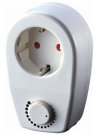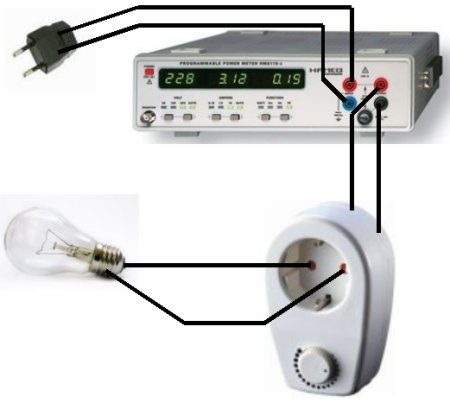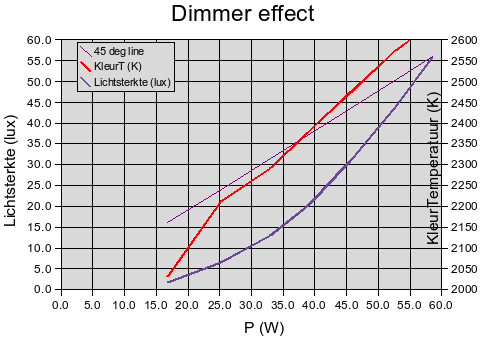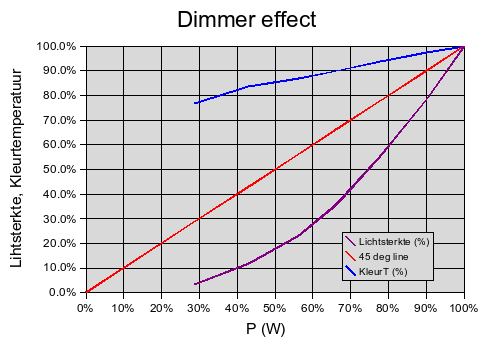How efficient is a dimmer
Posted by Marcel van der Steen in Explanation, LampsTags: light Add comments
Dimmers are used in many places, to gerenate the requested atmosphere. And one can believe that dimming also saves on consumed power, which is true, but how much?

The working principle of a dimmer
A dimmer that works for normal incandescent lamps and halogen lamps, works according to the principle of phase cuttting. See also the explanation on the OliNo website. The remainder of this article will give some practical measurement results on the efficacy of a dimer.
Measurement setup
A hameg power meter is used to measure the power consumed by the lamp that is measured. The following connections are made to measure the effect of the dimming action.

Figure: the measurement setup for measuring the dimming efficacy
Besides the illuminance and color temperature were measured with help of a color spectrometer.
The measurements were done as follows: the dimmer is positioned at a certain position. At that position the voltage, current, power (in Watt) illuminance (in lux) and color temperature (in K) were measured. The results were put in an overview graph.
Measurement results

Color temperature and illuminance value reported against the consumed power, for an incandescent lamp
One can see that the illuminance value does decrease much faster than the power does when dimming is increased. See also the 45 degree line in the graph and observe that the actual curve of illuminance compared to consumed power is below this 45 degree curse, indicating that the illuminance drops faster than the consumed power.
Also visible is the decrease of color temperature, from 2600 K to 2000 which has a yellow hue.

Relative power against relative illuminance and color temperature
It is easier to look at relative values. At a power of 25 % there is almost no iluminance left! So although the lamp seems to emit almost no light, there is still a considerable amount of power consumed.
The color temperature drops as well, which is a know behavior of incandescent (and halogen lamps); when less power is burned in the lamp, the temperature gets lower and hence the white light coming from it gets a more yellow hue.
The loss of energy
Using the last figure it is easy to define the energy loss. Assume one dims the lamp at 50 % of the illuminance. Then follow the purple line and see that the power consumed is still at 75 %. So when using most of the time the dim-position at 50 % then the light is at 50 % but the power still ay 75 %.
The loss of light being more than the reduction of power consumed is because the lamp emits loss less light at lower temperature of the filament.
If one is using the dimmer quite often, then the following table indicates the remaining illuminance at a certain power consumption.
| Dim position [%] | 40 W lamp | 60 W lamp | 100 W lamp |
|---|---|---|---|
| 0 | 0 W | 0 W | 0 W |
| 10 | 2 W | 3 W | 5 W |
| 20 | 4 W | 6 W | 10 W |
| 30 | 6 W | 9 W | 15 W |
| 40 | 8 W | 12 W | 20 W |
| 50 | 10 W | 15 W | 25 W |
| 60 | 12 W | 17 W | 29 W |
| 70 | 12 W | 19 W | 31 W |
| 80 | 13 W | 19 W | 32 W |
| 90 | 12 W | 18 W | 30 W |
| 100 | 0 W | 0 W | 0 W |
Intention of this article is that the more and more often one dims a lamp, one should be aware that the power consumed is still considerable and dropping less than does the illuminance. Dimming can then better be done by using smaller wattage lamps and switching so now and then additional lamps for more light if needed.



Most popular posts